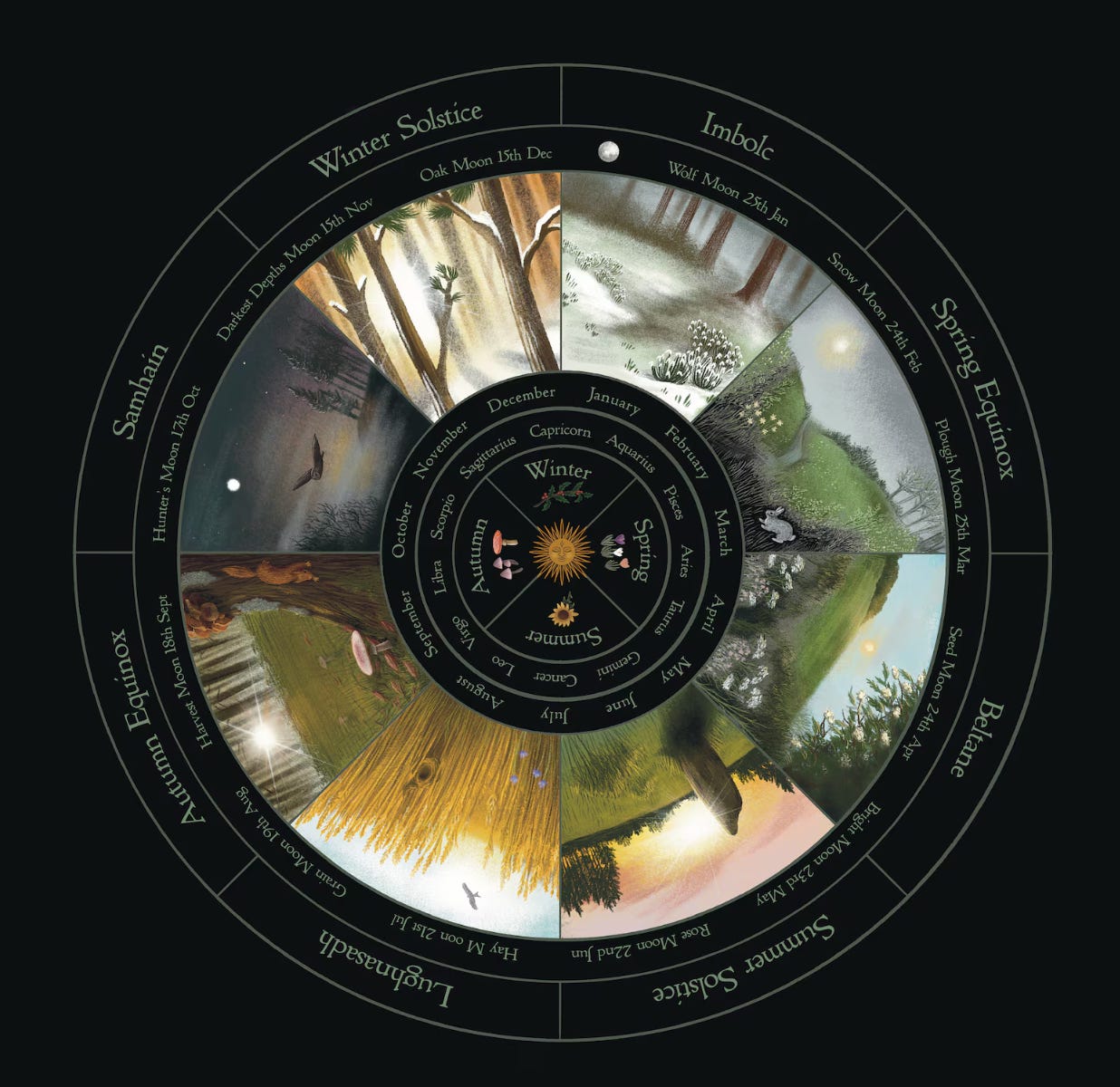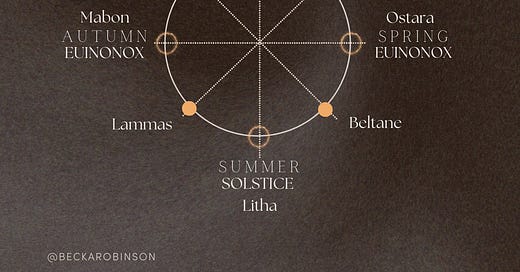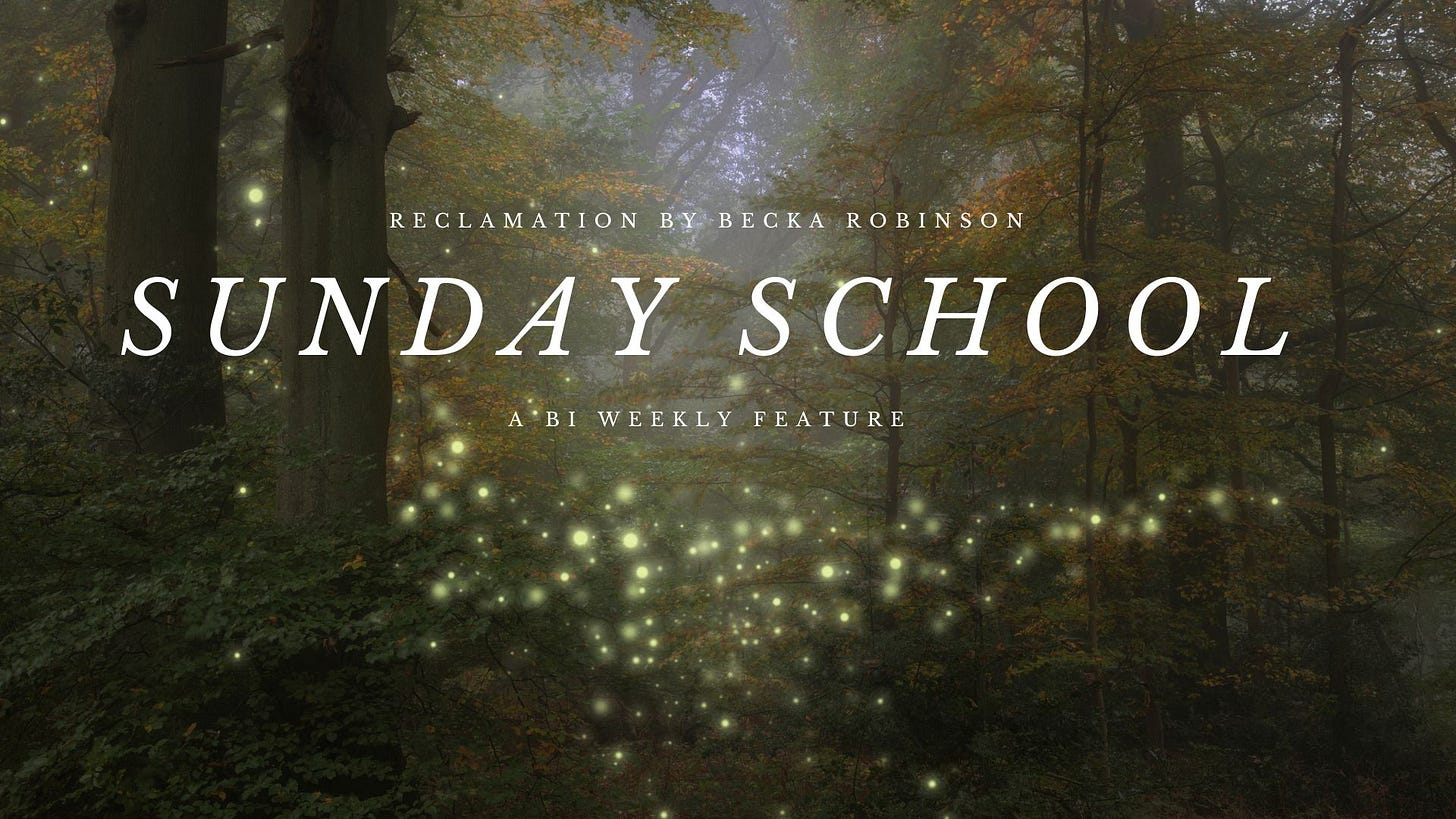It started with some standard late night revenge procrastination going down some tik-tok rabbit holes. Winter was coming and I was already thinking of ways to make the month of December feel special beyond just Santa and presents. How to make the season meaningful without the nativity story. That’s when I found it… The Whell of the Year.
Hi. I’m Becka. I’m a healing artist and writer trained in therapy modalities like Rapid Resolution Therapy and Hypnotism as well as how to coach people dealing with Religious Trauma and this is Sunday School, a bi-weekly series here on the Reclamation Substack where we dig a little deeper into things that you might be curious about but too busy to do your own deep dive on. While we’ll be digging deeper into these subjects, these posts will still be meant as introductions. Not everything will be your tastes and that’s okay. Sample it all and see what you like.
My introduction to the Wheel of the Year came through the holiday of Christmas. I was researching all the various traditions I loved so much from the holiday because I was desperately searching for a way to feel rooted after I’d removed the nativity story from how I celebrated.
As I researched things like the Christmas tree, candles in windows, a holiday feast, giving gifts, holly, baking Christmas cookies, basically all the things I enjoyed about the holiday, I was finding that they were all rooted in ancient pagan traditions from a festival called Yule that happened during the Winter Solstice each year.
(If you want to read more about how I changed the way our family celebrates Christmas I have gone into great detail in my Reclaiming Rituals series here.)
It didn’t take me long to find the Wheel of the Year. An official description explains it as a visual representation of the eight “Sabbats”, or religious festivals, of Neo-Paganism and the Wicca movement. The Sabbats include four solar festivals (Winter Solstice, Spring Equinox, Summer Solstice, and Fall Equinox) and four seasonal festivals that mark a significant seasonal change. The Wheel of the Year also marks the year's chief solar events (solstices and equinoxes) and the midpoints between them. 1

So you’ve got the big four solar moments: Winter Solstice, Summer Solstice, Spring Equinox and Autumn Equinox. Then you have the midway points between those. I know the graphic above might make you feel a little cross eyed, especially if you are new to this stuff. Or, it may spark a sense of anxiety if you grew up in a high control religion that demonized anything related to astrology or charting the stars, sun, or moon. But take a deep breath and hang with me, because nature is your birthright, and that’s all we are really doing here. We are using this incredible tool to reconnect with nature, its shifts, its messages, and ourselves within it. I made a simplified version of the chart for you in case this helps…
First find the big four: solstices and equinoxes. Odds are you’re already familiar with these as some of our most popular holidays fall on them: Christmas and Easter. 4th of July in America is also extremely close to the Summer Solstice and a case can be made for fireworks being reminiscent of an ancient fire festival. Halloween coincides with Samhain. And while Mabon happens earlier than we celebrate it, it’s giving serious Thanksgiving vibes. (In fact, reclaiming Thanksgiving in our household was made into something much more beautiful by pulling in traditions from Mabon and Lammas and foregoing the pilgrim story. More on that in an upcoming Reclaiming Rituals feature this fall! Those posts are for paid subscribers so upgrade if you’re interested!)
The festivals to mark each of these seasonal milestones, each with their own lore and traditions, correlate to the shifting seasons. For example, Yule in the Northern Hemisphere is during the Winter Solstice which is the day that the earth gets the shortest amount of sunlight making it the the “longest night” meaning everyone in the northern hemisphere experiences more hours of darkness than daylight on that day. Festival traditions there include making and lighting candles, staying warm with loved ones by the fire, sharing food and gifts, etc. I, personally, like to celebrate the resolution and goal setting tradition of New Year on Imbolc instead of on January 1st. January 1st is still the depth of winter, nothing in nature is waking up and grinding yet. I find it much more aligned to only just start envisioning those new goals for myself on Feb 1st as nature is only just beginning to stir.
There’s arguments about when the Wheel of the Year began to be called by the name “Wheel of the Year” and I don’t claim to be an expert on that. The ancient people groups that celebrated these seasonal shifts were found all over the globe and weren’t united by calling their calendars “the wheel of the year”. It was an intuitive way to celebrate as a village and mark the impermanence of things, the name came later.
Wiccans and Neopagans call this calendar the Wheel of the Year and they celebrate the festivals calling them “sabbats”. This is where people, especially those deconstructing from Christianity can get a little sweaty. I get it. I used to be really fearful around anything “witchy” but I promise that if you look past that programmed fear reaction you’ll see that this is older than Wiccans and Pagans and there’s much for us to learn and be inspired by here.
Also, it’s helpful to note that the Wheel of the Year’s festival names are taken from northern European traditions and mythology. But remember that those are not the only people groups who celebrated seasonal shifts. We are simply using this as a calendar, an introduction to the rhythm and paying attention. So don’t get too stuck on the names of each festival when they may be named for gods and goddesses that are not a part of your ancestry and that you may feel zero connection to. That’s okay, pay more attention to the seasonal correspondences and connections than the names.
The Seasonal Celebrations of the Wheel Simplified:
Let’s do a quick breakdown for you: (this is written for Northern Hemisphere, in the southern hemisphere they are simply reversed so the summer solstice would be in December)
Winter Solstice - Yule/Christmas - themes: hope, darkness, return of the sun, gift-giving, decorating with light and things that shimmer, sharing food, evergreen as a symbol of resilience. Symbols: light, candles, evergreen trees and branches, holly, mistletoe, the star, carolling, bells
Imbolc - (Feb 1) the halfway point between the winter solstice and the spring equinox - themes: new year, first sign of life after winter, the name means “in the belly of the mother” and refers to a gestation, things beginning to stir. Envisioning what is to come. It’s like nature’s new year. Symbols: white (for purity), green (for new life) candles/flames, a brigid’s cross, swans, serpents (awakening), bay leaves
Spring Equinox - Ostara/Easter - themes: rebirth, resurrection, balance between the light and the darkness, victory of light over darkness as we move toward the summer solstice, fertility, joy, renewal. Symbols: rabbits, eggs, butterflies, bunnies, flowers, faries
Beltane - (May 1) the halfway point between the spring equinox and the summer solstice - themes: fertility, coming together of masculine and feminine energy, sex without shame, boisterous celebrating. Symbols: the maypole and other phallic symbols, colored ribbons and other feminine symbols, bonfires, wine and food.
Summer Solstice - Litha - themes: midsummer, peak of sun’s light and strength, inner power and brightness. Also a major shift happens here as every day from this point on grows a little darker toward the winter solstice. It’s a big seasonal shift. Symbols: sunflowers, fire, bonfires, roses, honeybees, the sun, water, daisies.
Lammas (also called Lughnassadh) - (Aug 1) the halfway point between the summer solstice and the autumn equinox - themes: traditionally this was the first of the harvest festivals so grain was abundant. Themes include those that have to do with harvesting: gratitude, abundance, hard work and diligence paying off. Symbols: grain, wheat, fruits and vegetables, bread, a feast, community gathering, breads
Autumn Equinox - Mabon - Associated with the start of fall and is the 2nd of three harvest festivals. (I use Mabon as a model for a reclaimed Thanksgiving) themes: balance, as this is the moment the light and the darkness are equal, gathering, gratitude, resourcefulness, diligence. Symbols: cornucopia, autumn leaves, apples, grapes, wheat and barley, harvest tools, sunflowers, pomegranates, feasts.
Samhain - (Oct 31/Nov 1) - the midway point between the autumn equinox and the winter solstice - themes: honoring the life death life cycle, connecting with and honoring ancestors, end of summer and harvests/beginning of the “darker” time of the year, costumes, divination. Symbols: ghosts, death, costumes, pumpkins, ancestors, spirits, lanterns, celebrating the last of the harvest, orange and black
Winter Solstice - (go back to the top and start again! It’s cyclic after all)
How To Use The Wheel
My favorite thing about beginning to use this calendar to mark the seasons shifting is that the celebrations feel less arbitrary and less based in consumerism. I like paying attention to why the traditions that endure were originally done. It adds meaning and intention to things and also adds a rooted undercurrent to my life. Instead of thinking, “Oh my gosh how is it already December?! I know it’s coming because I’ve been paying attention and honoring each stage leading up to that. It also helps me as I move through more difficult or challenging times to have an “end cap” of sorts to say goodbye to that season and usher in a new one.
The Wheel of the Year was how I began my Reclaiming Rituals journey of reconstructing how I (and my family) celebrated these big holidays after my husband and I deconstructed from evangelical Christianity. Christmas and Easter were especially hard holidays after we’d left the church as so much about them is wrapped up in religious symbolism. As my first child got old enough for us to begin to want to instill the stories and morals within them I was highly motivated to re-write how we interpreted the holidays. At that point I was involved in a bunch of groups for deconstructing Christians and I would watch each spring and winter as the members posted update after update about how hard the holidays were, how depressing it was to feel no connection to everything that held joy and nostalgia for them, and a deep sense of loss. I felt like if I could figure this out for me, maybe I could share it with them and some of them would be able to reclaim the holidays for themselves in a way that made them exciting and fun again too.
So you may be asking… which came first? The nativity story or yule? The resurrection story or Easter? The festivals that the wheel of the year are based in are older than Christianity. And you may be surprised (and possibly overjoyed) to learn that most of the traditions that the became synonymous with these holidays as religious themes are actually pagan. I go into detail about those for each holiday in my Reclaiming Rituals series. But as a quick example…
Two of the biggest themes of those holidays have to do with the seasons that those holidays originally were marking: Solstice and the Spring Equinox. Solstice being the darkest night and signifying that the sun (son?) had returned to the world. The day after solstice marked a return of the sun (son?) as each day from there till the Spring Equinox had a little bit more sunlight than before as the earth and sun danced into balance again in orbit. The celebration was one of hope in the dark, of celebrating the light coming back to the earth. I believe that at its core this is what the nativity story is trying to communicate as well. The Spring Equinox marked a time of fertility and rebirth. What’s a synonym for that? Resurrection perhaps? Yes it marked the new year of growth, the plants and animals and the earth being fertile again after a long, cold winter. After death (winter). The festival in northern Europe celebrated the goddess Ostara, who’s name is where we got the modern name “Easter” for the holiday. As the Catholic church crusaded across Europe it had to make concessions with the long-beloved traditions of the people it was colonizing. So to allow them to keep their holidays and even the traditions of the celebration they just giving it new names and background stories that coincided with Biblical stories. That’s why so many of those things are now thought of as Christian but they were much older.
Whether you find yourself here because, like me, you are looking for a way to find meaning outside the Christian or Nationalist traditions you grew up with, or whether you’re just trying to connect more deeply with nature and disconnect from the capitalistic consumerism of the big holidays, I hope this introduction to the Wheel of the Year is the beginning of a BEAUTIFUL evolution for you.
The Wheel as a Jumping Off Point
If you know your heritage, look into the ways your ancestors celebrated and marked these seasonal shifts. I have ancestry in northern Europe so a lot of the traditions used in these festivals feels rooted to me but don’t be afraid to look back to wherever your history leads.
As with most things, you’ll likely find that there’s nothing new under the sun and that traditions of your ancestors have a lot of similarities to others.
When it comes to celebrating seasonal shifts, you are never outside of your scope because you are a part of nature. Nature is your birthright. Paying attention to it, drawing meaning and wisdom and inspiration from it, learning lessons from it, and allowing it to be a teacher, and using it as a grounding rhythm to your life is all your birthright. So find what feels meaningful to you and start there.
What Now?
When I first started using the Wheel of the Year to pay more attention to seasonal shifts I started by just incorporating one or two small things I found. For Christmas we started by just rolling beeswax candles as a family and talking about what that celebration meant to the people back then… it was all about hope. (Which really, isn’t that what Christians celebrate on Christmas as well?) For Easter we incorporated a ton of fresh flowers from our garden and focused on garden and springtime based decorations and recipes. We even started growing carrots to use for a carrot cake each year. Each year we’d add a new tradition. These baby steps made the process less overwhelming and also allowed us to feel into what felt the most supporting and meaningful to us as we rebuilt our way of celebrating individually and as a family.
None of this is novel. It’s just meaning minus dogma. It’s celebrating without shame-based stories. I hope that you find something here that feels a little bit like home.
Let me know if you have any questions in the comments!
xo, B
Definition taken from the World History Encyclopedia, https://www.worldhistory.org/Wheel_of_the_Year





